#Joseph Hearst
Explore tagged Tumblr posts
Text
The Future of Ominis Gaunt
Don’t worry, this is just the beginning of my head canons for Ominis, I already have a couple of ideas for a story with him and his daughter that I will eventually write

Ominis took a few years to try and figure out who he was and make a path for himself that was not his family’s idea. He strove to protect muggles from being caught in the crossfire of dark wizard gangs and worked to keep the peace between both muggles and wizards.
He met the woman who would become his wife in 1906 who was the daughter of a muggle woman and half blood wizard, but was mostly raised by her mother. She was an actress and took part in many re-enactments of Shakespearean plays, all of which she had read at least once.
Evangeline was said to be one of the most beautiful people around, however after being caught in the middle of a duel between two dark wizard gangs, she got a scar on her face. However Ominis did not care what she looked like as she had a similar view to dark wizards and justice as he did and constantly said she looked perfect
In 1916, Ominis and Evangeline welcomed their only child, a daughter whom they named Gilda Noctua Elysian. The first name was chosen by Evangeline who believed that Gilda was the gold in her life, while the middle name was chosen by Ominis who wanted to honor his deceased aunt.
His daughter would go on to fall in love and marry, Thomas, a classmate of hers from her school days, a magica historian, and the son of one of Ominis’ closest friends, Phineas Hearst. He was pleased with the match and knew Thomas would take great care of his daughter.
The fact that Ominis was a Gaunt was an open secret amongst the family that eventually faded as the generations went on as it was very rarely mentioned verbally. In fact, after marrying into the Elysian family, he was always treated as if he was always a member.
In the 1940s Ominis and Evangeline would become grandparents to Joseph and Elijah Hearst. The former was sorted into Slytherin and became an auror who fought in both wizarding wars, while the latter was sorted into Ravenclaw and followed in the footsteps in becoming a magical historian after Hogwarts.
In 1953, he, along with Sebastian Sallow, attended the funeral of his friend, Phineas Hearst, after his sudden and unexpected death. In particular, Ominis comforted his son-in-law and grandsons following the loss. And would continue to tell fond stories of his adventures with Phineas.
Ominis lived long enough to meet his first great grandchild, Tobias Hearst, in 1968 before passing away peacefully the following year at the age of 88. In addition, Tobias was given the middle name of Ominis to honor his great grandfather’s legacy, in total, he would have six great grandchildren
#Ominis Gaunt#Evangeline Elysian#Gilda Elysian#Thomas Hearst#Joseph Hearst#Elijah Hearst#Tobias Hearst#hphl#hphl kids#Hogwarts Legacy#Harry Potter Hogwarts Legacy
18 notes
·
View notes
Text
Pulitzer doing this with Hearst in a another universe lol
(THIS CLIP IS FROM TVB 1983 IT IS NOT MINE)
3 notes
·
View notes
Text
youtube
3 notes
·
View notes
Text
I just had a contemporary world lecture and I have to be honest I’m usually so bad at paying attention in lectures but today’s was about imperialism and the emergence of mass culture in the 19th century US and I was so zoned in because the first slide had a picture of the New York World Building which immediately set off my Pulitzer Nerd Brain.
Anyway, this made me remember something that might actually be interesting to other Newsies fans (who aren’t as interested in the Pulitzer family as I am): Columbia University Libraries Online have a bunch of files and pictures and other interesting stuff related to Pulitzer, his family and the papers - including a couple of memos/telegrams sent from Seitz to Pulitzer about the newsboy strike. This is also good if you are as interested in the Pulitzer family as I am, they’ve got some family files/pictures as well.
I know other people might not be super interested in the actual historical details surrounding Newsies, which is fair enough, but it’s worth checking out and easier to look though than a lot of things related to Pulitzer and The World tend to be!
(I’m basing this on what I assume other people might actually want to know about, but if anyone is at all interested I could make a post about where people can learn more about the historical Pulitzer and his family.)
#it’s horribly rainy today and birmingham has been so busy with the schools off for half term#but i’m glad i came in because my lecturer actually mentioned pulitzer (and hearst) at one point#newsies#katherine plumber#katherine pulitzer#joseph pulitzer#mercury posting
7 notes
·
View notes
Text
my friend: hey, you were over there muttering under your breath for a long time, are you okay?
me: oh, yeah, i’m fine! i was just vocally stimming. it helps me calm down in overstimulating environments.
my friend: oh, okay! if you don’t mind me asking, what were you saying to calm yourself down?
me: oh, i was just reciting the entire script of Disney’s 1992 flop movie-musical Newsies starring Christian Bale and David Moscow from memory.
my friend: …
me: i didn’t remember it as well as i used to, since i haven’t seen the movie in two years, but i got through about the first thirty minutes, minus the songs, without too much trouble.
my friend: how do you not have an autism diagnosis
#lowkey disappointed i couldn’t get through more of the script#but backstage during a concert with choir kids is so overstimulating omg#autistic#autism moment#neurodivergent#newsies#92sies#IN 1899 THE STREETS OF NEW YORK CITY E C H O E D WITH THE VOICES OF NEWSIES#BRINGIN YOU THE NEWS OF JOSEPH PULITZER WILLIAM RANDOLPH HEARST AND OTHER GIANTS OF THE NEWSPAPER WORLD.#ON EVERY CORNER YOU SAW ‘EM CARRYING THE BANNER#BRINGIN YOU THE NEWS FOR A PENNY A PAPE.#POOR ORPHANS AND RUNAWAYS#THE NEWSIES WERE A RAGGED ARMY WITHOUT A LEADER.#UNTIL ONE DAY ALL THAT CHANGED…
13 notes
·
View notes
Text
Newsies Limited Series Idea (rewritten)
This was a concept from one of my year-old posts. I re-wrote a new outline for fun.
Title: Newsies
Logline: Set in 1899 New York, Newsies is a period drama that explores the social and political landscape of the era through the eyes of a group of newsboys struggling to make ends meet.
Overview: Based on the 1992 film and real-life events, Newsies is a fresh take on the beloved story that delves deeper into the lives and struggles of the newsboys. While the series will maintain the charm of the original, it will take a more serious tone, delving into the societal norms, identity, and friendship that are challenged during this time in history.
Themes: The series will explore themes of social justice, friendship, and identity as the newsboys come to terms with their place in a rapidly changing world.
Characters: Newsies features a diverse cast of characters, each with their unique story and struggles. Viewers will be taken on a journey through the eyes of the newsies as they navigate through the turbulent era.
Real-life and fantasy elements: The series will seamlessly blend real-life and fantasy elements by incorporating historical figures such as Teddy Roosevelt, Hearst & Pulitzer, Big Tim Sullivan, and some of the original newsies to create an engaging and unique viewing experience.
Musical elements: Although not a musical, Newsies will incorporate lyrics from the original songs into the dialogue, paying homage to the beloved music that made the original film a hit.
Distribution: The series will be available on Netflix or other streaming services, providing a broad audience with the opportunity to enjoy this exciting new adaptation.
Newsies is a period drama that explores the themes of social justice, identity, and friendship through the eyes of a group of young newsboys. With a diverse cast of characters and blend of real-life and fantasy, the series is a unique viewing experience that pays homage to the beloved original.
EPISODE 1: The Maine
The episode begins with a fade into July present-day. We see the city of New York below with its skyscrapers projecting brazenly into the sky, high above the street-level bedlam. We see the blur of vehicles in the city streets. The camera comes even lower, and we see rapidly moving traffic. The streets of lower Manhattan are saturated with cars. We see pedestrians darting in between the cars and hear the blare of a hip-hop recording that matches the frantic pace of the traffic. The camera zooms in even further, focuses on a young man eating lunch on the white steps of a building. He is scrolling a New York Times article on his cellphone as the camera begins to zoom out. We see the city as a rich mosaic of colors, which turns into an urban grey blur. The blur lasts for a few seconds.
Exterior, New York City, May 1968. Groovy guitar music. This time the buildings are not as stark, the traffic in the streets not quite so frantic. The cars are older. The camera focuses on a young man, eating lunch on a park bench. The newspaper he is reading has a headline about the assassination of Martin Luther King. We see the date. A hippie couple is sitting down not far from the young man reading the paper. The man puts his hand on her knee, and she places her hand lovingly atop his. We see them lean in closer as the camera starts to zoom out. She pulls away at the last moment as the shot becomes more distant and blurs.
Exterior, New York City, July 1920. Jazz music. The streets of lower Manhattan are still clogged, but this time, with old automobiles, men in straw boater hats chatting amiably in one corner. On another corner, two schoolboys—one Puerto Rican and one Italian—fight as other boys cheer them on. The camera focuses on a young man reading an illustrated paper as he leans against a lamppost. The camera pans away from the young man and onto a crowded street in which we see pop-up stands and multilingual vendors. Here we see a young Chinese girl feeding bread to pigeons. She tries to frighten away a larger pigeon. It refuses to move, and she waves her arms, sending the small flock of birds into the air as the camera zooms out again to a blurred view of the area.
Exterior, New York City, 1898. Then the sound of fiddling folk music rises as the camera slowly moves in once again. The streets of lower Manhattan are indistinct but sharpen gradually. We hear the clicking of typewriter keys and presses rolling. Words appear on the screen with articles from Spanish-American War. Newsboys are running around, shouting headlines and selling papers at a rapid pace. The camera then focuses on a young boy, Jack, as he jostles his way through the crowd, calling out for customers. War with Spain is splashed across the headlines. The sinking of the Maine.
As he makes his rounds, we see snippets of other newsies - a group of brothers goofing around, an older boy giving a paper to a passerby with a sly smile, and a young girl standing timidly in the corner trying to sell her papers.
As Jack continues to sell, we hear snippets of conversations about the war, with people eagerly devouring the news of battles and victories. The price of papers has gone up, but nobody seems to mind. Business is booming for the newspaper tycoons, especially William Randolph Hearst and Joseph Pulitzer.
We then get a glimpse of Hearst's flamboyant and cynical personality, as he cracks jokes with his reporters and revels in his wealth and power. Pulitzer, on the other hand, seems more reserved and conflicted, torn between his duty to report the news and his desire to sell papers.
Meanwhile, we are introduced to the Jacobs family, a close-knit group who are doing better than most during the war. Mr. Jacobs is a hard-working man who is proud of his family, including his son David, who is top of his class, and his daughter Sarah, who loves playing the piano. Mrs. Jacobs, however, is a bit more skeptical, especially when her son Les brings home a stray kitten.
We also meet Brian Denton, a young reporter for the New York Sun who is eager to make a name for himself. He is tired of covering society columns and longs to write about something more meaningful, like the war. He meets with his childhood friend, Nellie Bly, who gives him some advice on finding good stories.
But Denton's boss warns him not to go too far in his quest for a scoop. They must stay competitive with other papers but not resort to sensationalism.
As the day progresses, we see more of the newsies' hardships, including Jack standing up for his friends and the younger kids. But things take a turn when Jack has a chance encounter with Snyder, an aggressive warden who seems to have it out for him.
Jack manages to escape but bumps into David on his way out. David is heading to a lecture hall, and Jack convinces him to pretend he's a student so he can hide from Snyder.
Meanwhile, the Delancey brothers, two mischievous newsboys, get jobs at their uncle's distribution center, while Mr. Jacobs gets injured on the job and is fired. The family is now in financial trouble, and they must sell their beloved piano to make ends meet.
As the episode ends, we see Jack and his newsie friends rallying to help the Jacobs family in their time of need. It's a testament to the bond that has formed between them and the sense of community that has grown among the newsies.
Overall, the episode highlights the excitement and chaos of a time when newspapers were the primary source of information for the masses. It also highlights the struggles and hardships of those who relied on selling papers to make a living.
EPISODE 2: The Strike
The episode opens with a glimpse of the New York City skyline, which looks different from today's. Then, the camera focuses on two young boys, David and Les, walking down a busy street. They look determined yet apprehensive.
The episode continues with David and Les arriving on the scene as they desperately search for jobs to support their family. Jack recognizes David from their previous encounter and takes them under his wing to teach them the tricks of the trade. Through Jack's narration, we are introduced to the different newsies, their selling spots, and their personalities.
The newsies are struggling to make ends meet as prices have not been lowered since the war, and several have been forced to vacate their lodging house due to the inability to pay rent. Kloppman mentions the death of one of their friends due to starvation, which scares many of the newsies into taking action.
David suggests the idea of a union, which Jack considers as he recalls the trolley strike. However, the newsies are divided on the issue, with some unwilling to risk their livelihoods. Some of them quit and take up other trades, leaving only a small group of strikers.
Jack takes charge of the strike with David as his second-in-command. They attempt to negotiate with Pulitzer, but he throws them out immediately. The Delancey brothers taunt Jack, but he fights them off and earns the respect of the other newsies.
The episode introduces the mysterious and intimidating Spot Conlon, who is rumored to be a powerful newsie in Brooklyn. We see flash cuts of him beating up rival newsies, but we never see his face.
As the strike continues to escalate, the newsies become more organized, with Jack and David leading the charge. They eventually catch the attention of the media, which brings more attention to their cause. The episode ends with a cliffhanger as we see Pulitzer's reaction to the strike and the potential consequences for the newsies.
The episode is filled with gritty action, tense negotiations, and the struggle for justice in a time of great economic inequality. It captures the spirit of the newsie strike and the passion of the young boys fighting for their rights.
EPISODE 3: The Sacrifice
The episode opens with a montage of the newsboy strike in Manhattan, with newsies knocking over delivery wagons and getting into small fights with local distribution center workers. The strike has grown in numbers, but there are still a few newsies who are unable to contend with the lack of work and money and have given up.
The camera follows Crutchy Morris as he limps through the streets of Manhattan, his newsboy cap pulled low over his forehead. He stops in front of a delivery wagon, his friends gathered around him, and suddenly a scuffle breaks out. The sound of fists hitting flesh echoes through the alley as Crutchy's friends fight to protect the strike. Despite his hesitation, Crutchy joins in, throwing punches with his good leg. But the fight is quickly interrupted by the arrival of the Delancey brothers, Spot Conlon's enforcers. The Delanceys are ruthless and take pleasure in causing pain, and they have no qualms about targeting even the most vulnerable strikers. As the Delanceys advance, Crutchy throws himself in front of a younger striker to protect him. The Delanceys make quick work of Crutchy, landing blow after blow until he lies motionless on the ground. The camera shows the violence in graphic detail, with the sounds of bones breaking and blood splattering against the pavement. The Delanceys, satisfied with their work, leave the scene, leaving Crutchy and the other injured strikers behind. The police arrive to break up the fight, arresting some of the strikers and taking Crutchy and the others to the Refuge. The Refuge is a brutal place, with guards who take pleasure in causing pain to the children who are sent there. Crutchy, with his injured leg and broken bones, is particularly vulnerable. As the episode ends, the camera shows the other strikers gathered outside the Refuge, planning their next move. The strike has turned violent, with blood on the streets and friends being taken to jail or the Refuge. But despite the danger, they know that they cannot give up, not while the future of all newsboys is at stake.
EPISODE 4: The Girls
Opening shot: A crowded street in Manhattan, with newsboys shouting headlines and garment workers making their way to work. We meet Sarah Jacobs, a garment worker, who is listening to the newsboys as they talk about the strike. She's intrigued and decides to learn more.
Cut to: The Newsies' headquarters, where the boys are discussing the strike and the arrival of the garment workers. They are initially hesitant to accept their help, but Sarah speaks up and convinces them to let the women join in the fight.
Cut to: The Harlem streets, where the newsies and garment workers are fighting for the cause. The scene is violent and intense, with blood and sweat flying everywhere. Skittery is badly injured, and Sarah disguises herself as a boy to fight alongside the others.
Cut to: The aftermath of the fight, where the newsies and garment workers have been forced to retreat. Sarah is celebrated as a hero for her bravery in the fight, but the group is demoralized by the loss.
Cut to: Sarah's home, where she is visited by Spot Conlon, who warns her about the danger of continuing the strike. He tells her that she should leave the cause before it's too late.
Cut to: The newsboys' headquarters, where they discuss their options after the loss in Harlem. Some want to continue the fight, while others are ready to give up. Sarah speaks up and convinces them to keep fighting, despite the risks.
Cut to: The final showdown, where the newsies and garment workers are facing off against the police and the hired thugs. The scene is chaotic and violent, with weapons and fists flying everywhere.
Cut to: The aftermath of the fight, where the newsies and garment workers have won the battle, but at a great cost. Skittery is still recovering from his injuries, and many of the others are bruised and battered. Sarah is hailed as a hero, but she's lost friends and colleagues in the fight.
Closing shot: A weary and battered Sarah walking through the streets of Manhattan, looking up at the sky, wondering if it was all worth it.
EPISODE 5: The Dream
Opening Shot: A close-up of an old, leather-bound journal with the words "Jack's Memoir" embossed in gilding, a gift from Medda a year ago. The camera pulls back to reveal a young newsie, Jack, sitting on a bench, scribbling away in his journal.
Jack's voiceover: “Dear Ma and Pa, it’s been some weeks since you left me in the city. I pray this letter finds you hale and hearty. As for myself, I'm waist-deep in the strike, fighting for what's right. But it’s not as plain as I reckoned it'd be.”
Cut to: Jack and his fellow newsies picketing outside the newspaper distribution center, chanting and holding up signs. They are met by a group of burly men, hired to break the strike.
Jack's voiceover: "Well, we've had a few run-ins with the strikebreakers, but nothing that would ruffle a feather. It's the bulls that keep me up at night. They're getting as mean as snakes in a sack.”
Cut to: Jack and the newsies in an intense argument with a group of distribution employees.
Jack's voiceover: "It's a curious case we're in, my friends. Some of them fellows who handle the distribution shares our sentiments, but others are in a tight spot and simply trying to keep their livelihood. It's a conundrum, and I'm uncertain of the right course of action to take."
Cut to: Flashback of Jack violently attacking a newsie about his age who was selling papers.
Jack's voiceover: "Friends, I must confess to a regrettable incident. My temper got the better of me, and I wronged a lad who bore no ill will. It pains me to consider his sister, who depended on him to earn a living. I'm beginning to recognize the dual nature of this conflict; not every soul can afford to cease work.”
Cut to: Denton, a wealthy businessman, watching the strike from afar, a scheming look on his face.
Cut to: Jack and the newsies preparing for a major fight with the grown strikebreakers and cops.
Jack's voiceover: "We're fixin' for a mighty ruckus, and I'm a mite uncertain if we're ready for the scrap. But we've got to stand firm for what we reckon's right, come hell or high water."
Cut to: Jack's infamy spreading to other newspapers, including Snyder's usual paper, a corrupt prison warden with a vendetta against Jack.
Closing Shot: Jack closing his journal and looking up, a determined look on his face.
Jack's voiceover: “ I ain't the one to prophesy the future, but I reckon I gotta keep on fightin' for what's right. Perhaps I'll head west, but not 'til we've settled this strike. I owe it to my fellow newsies. By the way, have you seen how them stars glitter over the canyon at night?" "
The screen fades to black.
EPISODE 6: The Ambassadors
Opening Shot: A wide shot of a scorching hot New York City street. We see newsies in ragged clothes walking around with signs and water cups. One of them, Mush, is sweating profusely.
Mush's voiceover: "This is the burnin'est week ever seen and here we are protestin' in the streets. It's a tough goin', but we knows we gotta keep pushin' for what's fair and square."
Cut to: Kid Blink and Mush cracking jokes and trying to keep their fellow newsies' morale up.
Kid Blink's voiceover: "Me an' Mush, we're doin' our damndest to keep everyone's chins up, but it's gettin' tougher by the minute. We're in dire need o' funds, an' some o' our own boys are jumpin' ship an' workin' for the enemy. It's enough to make a fella's heart break.”
Cut to: Flashback of a newsie crossing the picket line, and the others shouting at him in anger.
Mush's voiceover: "It's a sight to break a newsie's heart, to see our own kind turning against us. But we won't give in, no sir. We've got backing from other boroughs, and we'll hold fast and see it through."
Cut to: Denton conducting interviews and running stories in the Sun, catching the attention of powerful figures like former newsie and senator Big Tim Sullivan and Roosevelt.
Cut to: Pulitzer in his office, looking at his plummeting circulation numbers.
Pulitzer: "I cannot permit this strike to continue indefinitely. The boys will inevitably exhaust themselves. We must remain steadfast and bide our time."
Cut to: Pulitzer's wife confronting him about the strike and trying to talk sense into him.
Pulitzer's wife: "They are but mere children, Joseph. You must see reason."
Cut to: Flash cuts of Mush and Kid Blink visiting various parts of the city, trying to convince newsies to join the strike.
Mush's voiceover: “We're tryin' to be messengers for the other boroughs, ya know, tryin' to get 'em to join the strike. It ain't no easy job, but we're makin' progress, by jove!”
Cut to: Medda holding a rally at Irving Hall in support of the strike, preparing for the event.
As Medda reminds her employees, “Well, darlings, I think it's high time we showed our support for the newsies by holding a rally! We can't just sit back and do nothing when there are injustices to be fought. I understand some of you might be worried about your careers being tarnished by Hearst's or Pulitzer's papers. But let me tell you this, my dears, if we let the fear of bad press silence us, we'll never make any progress. We must be brave and stand up for what's right, no matter the consequences.”
Closing Shot: A close-up of Kid Blink and Mush's determined faces as they continue their work, trying to keep the strike alive.
Kid Blink's voiceover: "We ain't givin' up, boys. It's our duty to fight for what's fair, no matter the cost. We’ll stick together like glue.”
The screen fades to black.
EPISODE 7: The Cavalry
The episode begins with a colorful, symmetrical shot of the newsies preparing for battle, their slingshots at the ready. The scene is contrasted with the dark, shadowy figure of Hearst, who is seen orchestrating the ambush from afar.
As the fight breaks out, the camera follows the chaos and violence in a series of quick, snappy shots. The newsies are clearly outmatched, but they fight on with all their might. Meanwhile, Racetrack narrates with his characteristic wit and humor, providing commentary on the battle and the various characters involved.
As the Brooklyn newsies arrive, the tone shifts to a triumphant one. The camera lingers on their colorful attire and unique personalities, capturing the spirit of the newsies' unity in the face of adversity. Spot Conlon, a striking figure in red suspenders, takes charge and helps turn the tide of the battle.
The scene then shifts to a quieter moment, as Jack, badly injured and beaten, is relieved by Spot. The two have a tense moment of conversation, with Spot offering a mix of tough love and support to Jack. The camera focuses on their faces, framed by the chaos of the battle behind them.
In the aftermath of the fight, the newsies regroup and the strike committee is formed, with Spot and Racetrack both taking on important roles. The camera captures the formation of the committee in a series of symmetrical shots, with the newsies arranged in a neat, orderly formation.
As the episode draws to a close, the camera lingers on the injured newsies, as they receive medical attention and the others tend to their wounds. The scene is shot in soft, warm light, emphasizing the compassion and camaraderie of the newsies. The episode ends with a hopeful note, as the newsies continue to fight for their rights and their dignity in the face of oppression.
EPISODE 8: The Rally
The rally episode of the newsies strike would be filled with quirky and whimsical details. The newsies, dressed in their mismatched outfits, gather in a park filled with bright colors and unusual decorations, like a giant topiary of a newspaper or a fountain spouting ink instead of water.
During the rally, Mr. Jacobs gives a stirring speech while standing atop a platform made of old newspapers, while the newsies use a megaphone made from a discarded gramophone horn. As the rally reaches a fever pitch, the police arrive, clad in stiff, uniform outfits that contrast sharply with the newsies' eclectic fashion.
The ensuing battle between the newsies and the police is filmed in slow-motion, with quirky, over-the-top action sequences that emphasize the physical comedy of the fight. Meanwhile, Medda's theater is transformed into a makeshift hospital, with colorful bunting and streamers hanging from the walls and the newsies' injuries patched up with bright, mismatched bandages.
As the newsies recover, Skittery narrates the events with his usual dry wit and sarcastic tone, giving a running commentary on his fellow newsies' quirks and foibles. The rescue attempts for Jack are shot like a heist movie, with inventive gadgets and daring stunts that wouldn't look out of place in a spy film.
By the end of the episode, the newsies emerge victorious, with the public opinion swayed in their favor and Jack safely returned to their ranks. Racetrack, with his fast-talking and charismatic personality, is promoted to the spokesman of the strike committee, and the newsies celebrate their victory in a colorful, eccentric party filled with dancing, singing, and more newspaper-themed decorations.
EPISODE 9: The Nightmare
The episode opens with David staring at the kitten, worried about its well-being. He turns to Les and promises to find a way to keep the cat fed. Meanwhile, the newsies are determined to intensify their strike and make a stronger statement to the city. They gather on the Brooklyn Bridge, chanting and holding signs, effectively bringing traffic to a standstill.
As the day wears on, David becomes increasingly tempted by the idea of scabbing to earn money for his family. However, he is conflicted because he doesn't want to betray his friends and their cause. The internal struggle is portrayed through a series of quirky, visually striking sequences.
Meanwhile, in the Refuge, Crutchy and the other imprisoned newsies are organizing and planning their next move. They work together to write down their stories and the conditions they are living in, hoping to bring attention to their cause. Crutchy manages to slip the notes and letters to Denton during a visit, under the guise of an interview with Snyder.
Denton takes the notes to his friend Nellie Bly, who is an investigative journalist. Together, they publish an article that exposes the harsh living conditions and abuses that the newsies face in the Refuge. The article creates a public uproar, and the pressure forces the city to release the imprisoned newsies, including Crutchy and his friends.
The episode ends with David ultimately deciding to stand with his fellow newsies and their cause, even if it means sacrificing his family's comfort. The newsies celebrate the victory of their comrades' release, and the kitten is finally fed, much to Les' relief. The episode's final scene is a signature tableaux shot of the newsies standing triumphantly, with the Brooklyn Bridge in the background, as they continue their fight for justice.
EPISODE 10: The Legacy
The final episode of the period drama "The Newsies' Strike" opens with a montage of newspaper headlines reporting on the continuing strike by the newsboys against Joseph Pulitzer and William Randolph Hearst. Despite facing police brutality and violence from scabs, the newsies refuse to back down and continue to picket and sell newspapers in their own way.
As the strike drags on, the circulation of both newspapers hits a record low, and the financial pressure on the publishers mounts. In a last-ditch effort to end the strike, Hearst and Pulitzer agree to a meeting with the newsies' leaders.
The meeting is held in a grand hotel room, filled with ornate furnishings and intricate wallpaper, all rendered in signature style. The newsies are dressed in their best clothes, but still look slightly out of place in the opulent surroundings.
After some tense negotiations, a compromise is reached: the publishers agree to buy back any unsold papers from the newsies from now on, and an official newsboy union is formed to represent the newsies' interests. The newsies are ecstatic, and the meeting ends with handshakes and smiles all around.
In the following scenes, we see the aftermath of the strike. Some of the newsies move on to other professions, such as delivery drivers and factory workers. Others continue to sell papers until they outgrow it and move on to bigger things.
The final moments of the episode show where each featured newsie ended up in life, both real and fictional. We see Jack, the charismatic leader of the strike, as a successful & philanthropic businessman in his later years. Davey, the intelligent and analytical newsie, becomes a lawyer and fights for workers' rights. Crutchy, the newsie with a limp, opens his own shoe repair business. And Spot Conlon, the tough Brooklyn newsie, becomes a detective.
As the camera pans out to present-day New York city, we see the old lodging house where Jack and so many of the others lived still stands today, preserved as a historic landmark. The Jacobs' flat, where Jack found a second family, is now part of the tenement museum.
Neither Hearst's nor Pulitzer's newspaper survived to the present day. But the legacy of the newsies' strike lives on, as a symbol of the power of collective action and the fight for justice.
Finally, the screen goes to black, and the sound of the newsies' fading victory chants echoes through the appearance of the credits. The end.
#Newsies#newsies musical#Newsies strike#newsies 1992#1992sies#Jack Kelly#david jacobs#spot conlon#racetrack higgins#crutchy#sarah jacobs#medda larkson#Denton#skittery#mush meyers#kid blink#specs#joseph pulitzer#Hearst#Teddy Roosevelt#nellie bly
41 notes
·
View notes
Text
an alternate universe where their rivalry is Mr. Pulitzer putting globes in Hearsts office or something
#I'm bored and it popped into my head#thought it was funny#don't take this seriously please#newmsies#joseph pulitzer#william randolph hearst#but the newsies version of both of them
2 notes
·
View notes
Text























William Randolph Hearst founded the Hearst Corporation on March 4, 1887.
#Hearst Tower#959 Eighth Avenue#Joseph Urban#George B. Post & Sons#Art Deco#Norman Foster#Hearst Building#Hearst Magazine Building#USA#Midtown Manhattan#New York City#5 3rd Street#Market Street#travel#San Francisco#California#architecture#cityscape#A.C. Schweinfurth#Mission Revival style#William Randolph Hearst#founded#Hearst Corporation#4 March 1887#anniversary#US history#original photography#vacation#tourist attraction#landmark
3 notes
·
View notes
Text
Macabre Month 6 Part IV: Aileen Wuornos: American Boogeywoman (2021)
In today's review, I find that the bicentennial is the perfect place to start retelling a serial killer's story. As I attempt a #positive review of the 2021 Aileen Wuornos: American Boogeywoman #PeytonList #TobinBell #LydiaHearst
What drives someone to kill? The pursuit of Wealth? Power? Some twisted logic or belief that only makes sense in their head? Or just mere circumstances coupled with a rash, impulsive decision. Many will have their theories, but the end motivations may be unknowable, even for the big cases. In 2021, controversial director, Daniel Farrands hemmed another alternative look at the legacy of another…

View On WordPress
#2021#Andrew Biernat#Ashley Atwood#film#films#Hamish Sturgeon.#horror#Joseph Schwartz#Lydia Hearst#macabre month#Meadow Williams#Movies#Nick Vallelonga#Peyton List#positive#review#Swen Temmel#Tobin Bell
2 notes
·
View notes
Text

"But Me No Butts!"
September 22, 1908
Governor Haskell of Oklahoma runs from William R. Hearst depicted as a goat. He carries a Government Guarantee of bank deposits, the Democratic Campaign Fund, and Political Dynamite. Senator Foraker of Ohio looks on from over a fence.
The caption reads "The Democratic Campaign Treasurer decides to take no chances of further attacks from the political William Goat"
Days earlier Hearst had revealed the payments that the Standard Oil Company had been making to Senator Foraker of Ohio, and had ruined his political career. Haskell was also mentioned in the same speech as being involved with the Standard Oil Company, and allegedly rising to his position as treasurer of the Democratic national committee because of this, claims he roundly denied.
See Also: William Randolph Hearst
From Hennepin County Library
Original available at: https://digitalcollections.hclib.org/digital/collection/Bart/id/6957/rec/2079
#charles bartholomew#political cartoon#american history#democratic party#joseph b. foraker#william randolph hearst#charles haskell#corruption
0 notes
Text
Joe Joseph Biden Trump Joe falcon hearst rapist, extortion kidnapping
Years and years of politicians celebrating that they reduced inflation by X%, boosted the economy, added some number of new jobs, etc etc.
Anyway, homes and rent are unaffordable, wages are stagnant, healthcare costs are rising, grocery bills have ballooned since 2021, student debt and college costs continue to rise.
I don’t care about the first list when nothing is actually affordable even after working multiple jobs. The first politician to address the real issues will be the most popular elected official in decades.
Don’t take my word for it, ask the majority of American, particularly younger generations, who continue to be f*cked over!
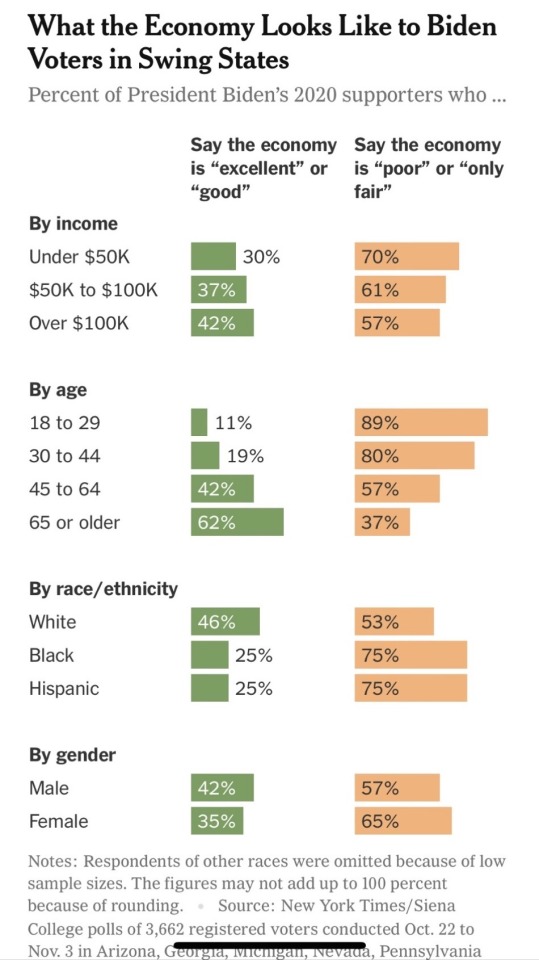
879 notes
·
View notes
Text
Experimentation
Part two of my rewrite for Year Seven, Chapter 51, major spoilers ahead for this chapter, also as the story goes on, there is angst, especially in this part
Some Nicknames and Aliases for R Members
Raijin -> The Leader, R, Rage
Zacharias -> The Overseer, Stygian
Verucca -> The Director, Chameleon
Pietro -> The Poison Brewer, Stonewall
Patricia -> The Curse Breaker, Flare
Kazuhiro -> The White Robed Wizard
Merula -> The Director’s Niece, Blight
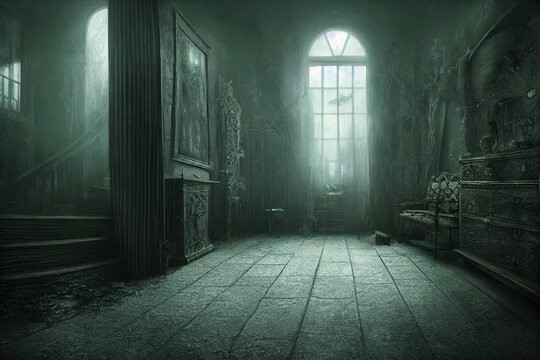
Helena was now surrounded by members of R and, as she lost her wand somewhere during the ambush by Verucca Buckthorn-Snyde, at the quidditch pitch. The plan was for her and Jacob to intercept a secretive test R was going to perform, however it backfired tremendously. Somehow, her brother managed to not be found and captured by the Director, so she supposed there was a sliver of hope. Still, she was not quite sure if she would ever see her wand again, or the light of day for that matter, as R’s headquarters hosted nothing but darkness within its walls and dimly lit interior. She was never a strong dueler, however even someone not skilled with offensive spells knew it
was better to have a wand then not have one. If only she had bothered to learn wandless magic, she thought. Perhaps she might have had a chance to stop the horrors that were destined to occur.
She looked helplessly at Erika, still dressed in her emerald green Holyhead Harpies quidditch uniform. She was standing opposite of her with an R member on either side of her. Even though, like Helena, she was not restrained, it would be foolish to try and run while being surrounded by so many powerful dark witches and wizards. The only option either of them had was apparation, thankfully both had their license and it was clear that there was no anti-apparation placed on the building due to a member of R apparating in every five or so minutes. However, Helena knew full well that she would not save herself through apparation if it meant leaving Erika behind,
and by the fact that Erika had not tried to escape by that method either meant the feeling was mutual.
Suddenly, they were joined by the infamous leader of R and two other high ranking members of R that Helena had always assumed were his most trusted colleagues based on the stories she heard from Jacob. Everyone she had ever met had either referred to the leader of R as either R or Rage, however both gave out the same feeling of mystery and fear. He was a young looking man of Japanese origin with long pitch black hair and dark brown eyes, however Jacob claimed that he was most likely older than he actually looked. Jacob always told her there were many things about him that even his most trusted advisors did not know, however, one thing they knew for certain was
that he was a descendant of Dai Ryusaki.
The man with greasy black hair and almost glowing brown eyes that walked on the right side of the leader of R was one that Helena knew unfortunately all to well from family gatherings. She did not see Zacharias Hearst much, however, even as a small child she knew there was more to him and plenty of dark secrets he was hiding. Apparently, the building they were standing in, was rumored to be his hideout and the host for many of R’s meetings and gatherings when not in the darkest corners of Knockturn Alley. For a while, she and Jacob managed to get an inside look on R by intercepting letters written to him about R’s new findings and meetings.
However, they assumed their little secret was found out as the letters became more and more sparse, still, it gave them enough information to come up with their original plan to take down R once they found the Sunken Vault. There, they had been ambushed by her former defense against the dark arts professor and two other R colleagues, however, they were able to capture Patricia Rakepick and one of her two colleagues, while the other managed to get away with a box of ancient treasures that now sat on a table next to a cauldron of bubbling liquid being stirred by an older man with grayish red hair and circular glasses. Helena now realized that retrieving this chest was R’s
plan all along, it did not matter who got captured, as long as they could retrieve the artifacts they so deeply desired.
The woman on the left of the leader was another figure Helena recognized. She had gray hair that made her look way older than she actually was, with only a bit of orange hair left in the form of her bangs, a Snyde family trait. Helena had first seen her during a failed ambush of R at Knockturn Alley which ended with only a few minor members of R being captured, yet the interrogations proved they knew nothing of importance. However, it did confirm to her of Merula’s betrayal of the Circle of Khanna causing for Ben and her to make an executive descision to ban her as Merula had chosen the murders who stole Rowan
Khanna away from them, rather than her classmates, some of which who even tried to extend a hand of friendship despite her previous actions, however, Helena recognized that unlike many of her storybooks, Merula was incapable of any redemption at this point, having rejected it too many times.
Helena watched as the leader looked at her sternly, “We tried to warn you, just like we did your brother. However, it seems that we must once again show you the consequences of opposing us, just like we did with your brother.”
“Then again I am personally not surprised by your disobedience, especially considering how rebellious your mother is.” Helena heard her great uncle comment which made Helena hold in a snort. He certainly had an interesting view of what disobedience was. “First she embarrassed the family by not being sorted into Slytherin, then pursued a childish dream as a career, and finished it off by marrying a filthy squib.”
“Let me propose you one final offer.” The leader spoke to her in the same tone he did before. “If you join us and swear to be loyal to R and only R, we will let your companion go free.”
“What’s the catch?” Helena hesitantly asked.
“I believe you are well aware.” Her great uncle informed her with a cocky smirk.
Helena honestly could see why her family despised her great uncle with some even fearing him. She remembered her aunt telling her and her brother over the holidays when they asked her if she knew anything about Zacharias and his possible acts of dark magic, with her only being able to tell them about a story where Zacharias would obliviate anyone who found out too much, being one of the best with the charm in his generation. He could easily implant false memories into anyone he encountered and the concept frightened her to the bone.
Helena looked towards her girlfriend, who, while not saying anything, did give her a look of sympathy, appearing willing to accept the decision she was about to make. However, Helena knew full well that the decision she was about to make would determine if she would be able to see Erika again. She figured it was selfish either way, for different reasons, but she figured the most bold decision was the proper one.
“I will never join you.” She sternly spat.
“So be it.” The leader accepted as he turned to the man near the cauldron and gave him a silent nod.
The older red haired man held a wand made of a brownish wood, “walnut wand, phoenix feather, unyielding, and thirteen inches in length.” The man verbally described the wand to the crowd, “a perfectly powerful wand to finish this potion, I thank you, Stygian.” The man finished before he turned back to cauldron and waved the wand over it, while muttering some spell Helena could not define, however something felt strangely familiar about that wand, Helena just could not put her finger on it.
“Do you recognize the wand?” She heard her great uncle suddenly ask. “I would not be surprised if you didn’t, after all, you were raised by your mother, the least traditional and worst Hearst in the entire family.”
Finally, it clicked for Helena once she ran through a mental recount of all of the wands stored in her grandfather’s home. She rarely went there, but when she did, she could not help but observe the wands of her ancestors, including her great grandfather, Phineas Hearst, who she now remembered, possessed a wand of that same description.
“How did you get your filthy hands on that wand?” Helena demanded.
“Oh calm down.” He casually replied. “Just asked my dearest younger brother if I could borrow it. When he said no, I took matters into my own hands. Do not worry, he is fine, he simply just does not recall the encounter, that’s all.”
It had seemed that during her banter with her great uncle, the man near the cauldron had given the potion to a younger member of R, a woman who looked to be around Gwenog’s age with pale skin, brown eyes, and short golden blonde hair, who had already placed the Crown of Mneme on her head. Something about her seemed familiar, perhaps if she and Erika made it out alive she could ask Gwenog. It was most likely just a student at Hogwarts who overlapped with her by two or three years that was on the popular side which allowed her to be recognizable even to younger kids, however, who the wearer of the crown was, meant little to Helena now.
“Now,” Helena heard the leader of R order, “Stand in front of Miss Rath and allow your feelings of negativity to flow like rushing water.”
“Don’t you dare!” Helena found herself snapping loudly, trying to free herself, hoping to manage to grab something and whack the young woman with the crown before it was too late. Was it foolish? Probably, but it was a worthless effort as two members of R held her back before she could do anything.
“Hmph.” She heard the leader begin, supposedly seeming unimpressed, “A childish demeanor like this is not suitable for a member of R, behave yourself”
“Take me instead!” Helena sacrificed herself, knowing full well that this was her first, not Erika’s
“Helena don’t.” Erika insisted sternly, accepting her fate, “I will not let you.”
Helena wanted to protest further, however, overhearing the wearer of the crown’s make a sudden comment distracted her, “I feel pain, heartbreak, anger…” she heard through grunts, “the dementors of Azkaban… my worst memories…”
The Sunken Vault! Helena did not know why she did not think of it sooner. She had deciphered that the crown most likely came from the collection of treasures R stole when Helena and her team encountered them at the end of her sixth year at Hogwarts, she herself even facing her own worst memories in that vault, which seemed to be an amplified version of what she faced in her third year. Helena tried again to stop the procedure, yet every time she moved, the members of R restraining her made sure she made little progress, it seemed hopeless, absolutely hopeless.
“Excellent!” The leader exclaimed with what seemed to be pride, something that disgusted Helena as the crown started to spark, “Now, Miss Court, channel those feelings into Miss Rath!” He demanded loudly and with a fierce force, “Now!”
Everything from there seemed like a blur. She watched helplessly as a beam of pure white light that acted like lightening came out from the crown and struck Erika in the chest continuously, only stopping when Helena heard someone yell out “Stupefy!”
It was enough distraction for her to escape her restraints and take cover. When the golden blonde woman fell to the stunning spell, the crown briefly sputtered out a few remnants of power before it eventually wore off. As a crowd of aurors came rushing in, picking duels with the members of R, she briefly caught a glimpse of Erika on the ground, seemingly not moving, although the distance could have contributed to that. However, her vision soon became blocked as duels broke out.
“Thought you might need this.” She heard the voice of her brother say next to her, placing a familiar object into her hand.
Helena looked down to see her wand in her hand and back up at Jacob, “Thank you, but how-“
“Later.” He interrupted her, “come on, let’s take down R, together, once and for all.”
Helena nodded before she followed her brother back into what had now become a battle field. She fought alongside him, firing off a number of spells and watched triumphantly as wands flew out of their hands, others falling to the floor, and others simply being distracted just long enough for an auror to cast incarcerous and apparate that auror to some other location for them to be detained, only for that auror to return shortly after to continue fighting and repeat the cycle, allowing for the number of aurors to eventually overtake the members of R.
It was certainly a challenge to duel when she was so distracted and not even a strong dueler in the first place, at least compared to her brother. When it came to the idea of dueling, her opinion was almost identical to her mother’s with only prioritizing on defensive spells and instead pouring all of her attention into the study of herbology, even though the cursed vaults and dealing with R stopped her from doing that most of the time.
She tried to find Erika among the chaos but failed to do so. It had seemed that between her time taking cover when the ambush occurred and her getting her wand back and fighting off members of R, Erika had managed to disappear. The fact concerned Helena as she figured there was no way Erika had enough strength to apparate on her own in the case that she was still conscious after being struck by the power of the Crown of Mneme.
Soon enough, the dark room only consisted of her, Jacob, her mother’s cousin and his son, Joseph and Toby and surprisingly her aunt along a few other Aurors who whom she had not noticed before.
“That should be the last of them.” She heard her aunt Cynthia assure Jacob.
“Good work.” Jacob satisfyingly replied, turning to Uncle Joseph, “Thanks for getting all of the Aurors together so quickly, I know it was not an easy task.”
“Not a problem at all.” Joseph assured him, “It is always a relief and a pleasure when we can take down one of these organizations, and it’s why we are always prepared to do so at short notice.” He then turned to his cousin, “You know you did not have to join us, you are on holiday with your family after all.”
Aunt Cynthia chuckled at his comment, “and let you and Olivia have all of the fun? No way.”
“Wait…” Helena reacted as she turned to her brother, “You allowed Mum to come here!? Why? She could have gotten hurt!”
“I know it was a risk.” Jacob admitted, “but I needed someone who could apparate you and Erika out in the case that one or both of you were injured before anything worse could happen. Mum was the first person who came to mind, you know she always told us how she was a prodigy when it came to Apparation. Plus, she is good friends with many of the healers at Saint Mungos, with her level of influence, she could get you and Erika to receive the proper care, we did not know what could have happened in the time you were in R’s hands.”
“I actually volunteered to come to help protect her.” Aunt Cynthia revealed, “Unlike Joseph and Toby I’m not an official auror for the British Ministry of Magic anymore and have not been since I married your uncle. It gave me a tad bit more flexibility allowing Joseph and Toby to help the others get more R members into custody faster. The plan always was for your mother to get out of there if there was no need for her. We found Erika pretty quickly and as her condition looked to be bad and Jacob had spotted you earlier and you seemed to be in good health and condition, she went ahead and apparated Erika to Saint Mungos for medical attention.”
“Honestly, she did quite well considering that stunning charm she cast was able to stop the affects of the crown.” Toby noted.
“Speaking of the crown.” Helena began, sounding concerned, “Where is it? Do not tell me a member of R still has their hands on it.”
“Relax.” Toby assured her, “I have it right here.” He said as she showed her the crown that she supposed he had been holding to this whole time, yet Helena hadn’t managed to notice.
“Me and Toby are going to take it to the ministry for safe keeping.” Uncle Joseph explained. “We will how some professionals examine the crown and determine the best course of action.”
Helena nodded as she heard her brother speak again, “I assume you want to go to Saint Mungos?”
“Yes.” Helena confirmed.
“I will go with you two.” Aunt Cynthia commented, “to make sure my sister is ok.”
“Catch up with you soon Cynth,” Uncle Joseph bid farewell before apparating away with Toby.
“It will be safer to do a joint Apparation.” Aunt Cynthia instructed, “it is a long distance after all.”
“Alright,” Jacob agreed while Helena silently nodded as the three grabbed each other’s hands, with aunt Cynthia leading the apparation.
Soon enough, the three of them were in the main waiting area of Saint Mungos. Helena watched as healers dressed in green robes scurried about. Scattered throughout the room were patients with a variety of conditions. A lot of them seemed to be magical mishaps such as one person floating in the air and another having the face of cat. However, eventually she spotted her mother, talking with one of the healers in a corner of the waiting room, although by the time they approached, the healer had already left and went back to where the patients were kept.
Her mother had seemed to sense their approaching and turned to them with a smile, “Good news is that she is going to be ok, the healers predict she will gain consciousness before the end of the day if everything else goes smoothly. However, as it was an injury caused by a magical artifact they don’t have a lot of knowledge on, they’d like to monitor her for a couple of days after that.”
Helena instinctively embraced her mother, “Thank you, …you did not have to do this”
Helena felt her mother returned the embrace and run her hand through Helena’s long dyed dark blue hair, “I know that Lena but I had to, for you. Now you need to rest, you have been through a lot…”
#there will be one more part to this#although if you like this I can write about Jacob and what he was doing during this#I apologize for the cliffhanger#wanted to do more but this part was getting too long#hphm#hogwarts mystery#hphm mc#harry potter hogwarts mystery#helena durazzo#erika rath#hogwarts mystery mc#jacob durazzo#leader of R#Raijin#Zacharias Hearst#Verucca Buckthorn-Snyde#Pietro Mulpepper#Joseph Hearst#Toby Hearst#Cynthia Hearst#Olivia Hearst#y7ch51
8 notes
·
View notes
Text
GQ Hype
How Sebastian Stan became Donald Trump in The Apprentice
With an uncanny performance as a young Donald Trump in The Apprentice and an even less recognisable turn in A Different Man, the shapeshifting actor is embracing his freaky side
By Ben Allen Photography by Daniel Jack Lyons
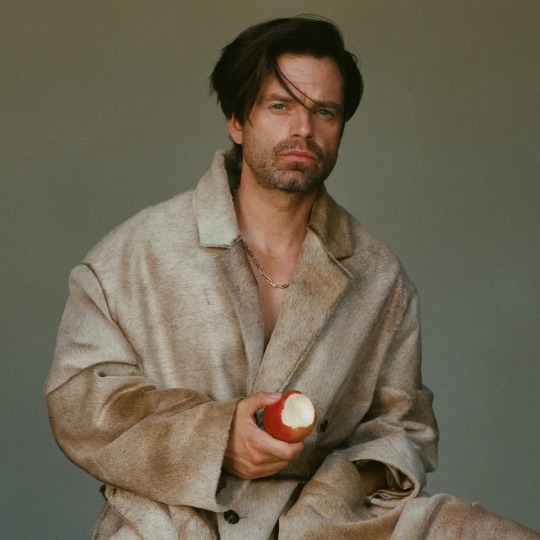
Coat by Loewe. Boots by Dolce & Gabbana.Necklace by Cartier.Daniel Jack Lyons
When Sebastian Stan was growing up in Romania in the 1980s, he began to learn English through passive immersion. His mother, a concert pianist, would regularly play English music and language lessons on the family record player while they were going about their day. “I’d be playing with toys and I’d hear, like, ‘frog’ and ‘dog’, or whatever,” Stan says. It meant that by the time the actor moved to Vienna at age eight, where he attended an American international school – and later, when he moved to New York at 12 – he had a decent jumping-off point. “I’m a big believer in putting yourself in a situation where, subconsciously, there’s work being done.”
In the past two years, Stan has put that method to use in a very different way. As he entered preproduction to play Donald Trump in Ali Abbasi’s The Apprentice – which charts the former President and current Republican candidate’s early rise through the New York property scene – he started spending his waking hours with tapes of the young Trump playing in his ears. He brushed his teeth with Trump, he went grocery shopping with Trump, he spoke to friends with one earphone in, Trump still nattering away in his ear. “I slept with him, by the way,” Stan says, well aware of how strange that sounds. “It just sort of ends up taking over your life.” He’s sitting somewhere in Los Angeles at lunchtime, speaking to me over Zoom, with the afternoon sun reflecting off his chlorine-blue eyes.
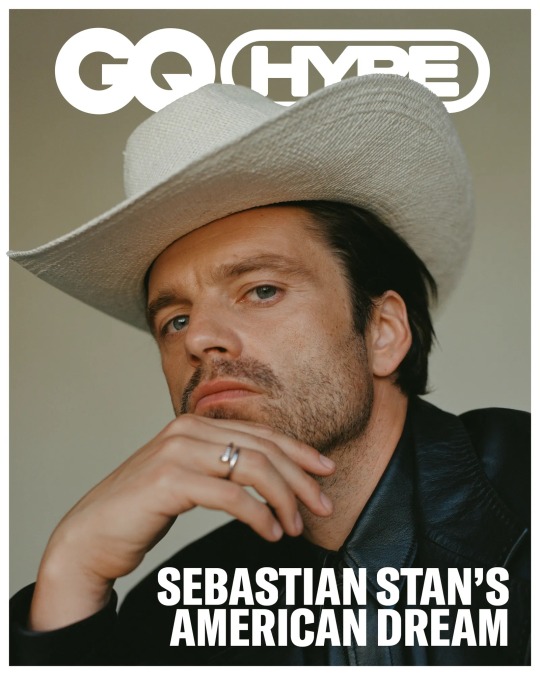
Jacket and shirt by Gabriela Hearst. Hat by Gladys Tamez. Ring by Cartier.
The Apprentice, which Stan first signed up for in 2022, explores the question, ‘How did Trump get like this?’ (The answer, it posits, has a lot to do with Roy Cohn, a lawyer and prosecutor who had risen to prominence in the 1950s as Senator Joseph McCarthy’s attack dog in the communist witch-hunts.) The film is the latest in a string of freaky, transformation-heavy roles that have run parallel alongside Stan’s very mainstream 13-year-and-counting stint as Captain America’s pal Bucky Barnes in the Marvel Cinematic Universe, which has made him a globally recognised action star. The Apprentice lands this month in the UK, two weeks after A Different Man, an A24 production in which Stan plays an aspiring actor with neurofibromatosis, a genetic condition that has caused the growth of non-cancerous tumours on his face. They’re not your typical actor-in-between-superhero-outings roles – and the fact that Stan is spending so much time in the make-up chair outside of the blockbusters is indicative of a desire to get truly lost in his work.
I started to think a lot about the American dream. What is it? Is it a ghost you keep chasing?
Preparing to play Trump, he says, was like any other time he has portrayed a real-life person – take, say, Tonya Harding’s ex-husband, Jeff Gillooly, in I, Tonya, or Tommy Lee in Pam & Tommy. But this time around it came with an added layer of stress. “There’d be nights when my anxiety levels would be through the roof, because I’d be like, Why did I say yes to this?” he says with a laugh.
But Stan thrives when he leans into fear. He had been terrified of I, Tonya, and even more terrified of Pam & Tommy – which, in its exploration of the couple’s romance and sex tape, involved a scene where Lee converses with a silicone puppet of his penis. (The latter earned him Golden Globe and Emmy nominations.) Trump was a different beast. “I thought, I don’t know if this is doable. I don’t know if I have it in me,” he says. “But it’s not not gonna happen because I’m scared of it.”
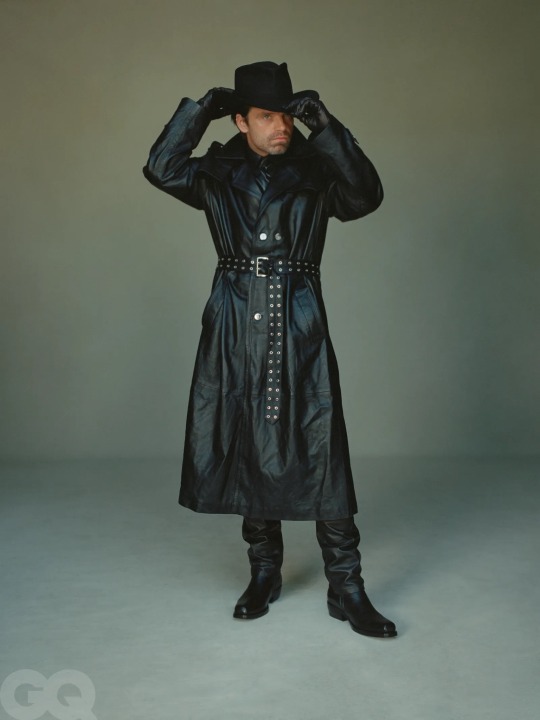
Coat, shirt and tie by Ludovic de Saint Sernin. Trousers by Gabriela Hearst. Boots and gloves by Versace. Hat by Gladys Tamez. Daniel Jack Lyons
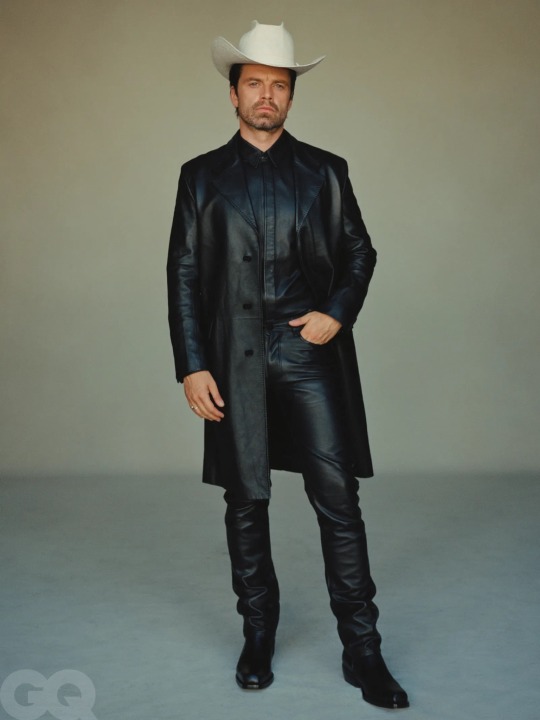
Jacket and shirt by Gabriela Hearst. Hat by Gladys Tamez. Daniel Jack Lyons
When his mother told him he was going to be leaving Vienna for the United States at 12 years old, Stan felt like the floor had fallen from beneath him. “It was like you were telling me that my life was over,” he says. His mother was a single parent and had met an American man and fallen in love; he wanted to bring them both to live with him in New York. Stan remembers crying in the shower in the days leading up to the move. After departing Romania a few years before, he had worked hard to forge new friendships. Now, he’d have to rebuild from the bottom up again. “That did feed me resilience, because it did allow me to get better at restarting and restarting,” he says. “It fed a lot of who I am.”
Upon arriving in America, he started working on his impersonation of an American teenager. “I was so traumatised by being different,” he says. He refused to speak Romanian, even at home. He didn’t tell anyone he was from a foreign country. “I wanted to change my name to Christopher,” he says. “I wanted to be as normal in America as anybody else.” Having already set the ball rolling with his passive English lessons as a child, he was able to adopt a seamless New York accent, leaving little to betray his otherness. He tried out every personality marker available to him at school, to figure out which one fitted: debate team, forensics, every sport he could muster, and drama, eventually gravitating towards the latter. “I became popular in high school through acting,” he says. “I went on dates. I found my path.”
Still, this otherness was a part of Stan, as much as he initially tried to suppress it. As he came to appreciate life in America – in a middle-class household, with a good education – he began to reappraise his background, and felt a sense of gratitude to his stepfather for bringing them over, and for the drive it seeded within him. “This idea that you’ve been so lucky to have been selected to get this opportunity,” he says. “I was able to seize it and work with it, but on the other hand it’s a never-ending burden because you go, ‘You better not blow it!’” He remembers taking a walk through the city on their arrival, gawping up at the skyscrapers, when his mother impressed upon him that very sentiment: “You see these buildings? This is where you have a chance to become something.” He thought about this conversation quite a lot while he was playing Trump, probably because it feels like a scene ripped right out of a more varnished biography of the former President. “I started to think a lot about the American dream, and sort of like, what is it?” he says. “Is it a ghost you keep chasing?”
That was a way of me understanding that you're just out there, like target practice.
When Stan was doing theatre in high school, he loved getting a chance to transform and become a different person entirely. “You’re 14, 15, and you’re playing parts where you have to be, like, 35 years older than you are, and you have to change your appearance, you have to change everything, and you have to walk a certain way,” he says. “That shit was fun.” He would find himself craving those meatier transformations later, after landing a run of roles in Hollywood playing traditionally hot villains and heroes in Gossip Girl and in the Captain America movies. “Watching Christian Bale do The Fighter and watching him do Batman and Vice and The Machinist… He was a guy that, to me, could have made very conventional choices because he’s very good at any of it. But then he’s trying these things.”
Opportunities like this aren’t necessarily afforded to nascent actors. In a weird way, you kind of have to wait for your face to become recognisable before you’re allowed to start messing with it. The first real taste Stan got of this was in 2017 – after he had been solidly established as a Marvel hero – in the Margot Robbie-led, Oscar-winning I, Tonya, which told the story of the assault on figure skater Nancy Kerrigan, orchestrated by her Olympic rival Tonya Harding’s camp. For Harding’s ex-husband – who sets the assault in motion – they were looking for someone very different to Stan. The real Gillooly is slight and short, with narrow features. Stan felt his teen-drama looks would work against him in the audition process. “I’m like, ‘I’m gonna walk into that room and they’re gonna see the taller guy, The CW [the young-people-melodrama US TV network that first aired Gossip Girl] guy.’ I felt like I was going to be immediately judged.”

Coat and pyjamas by Dolce & Gabbana. Daniel Jack Lyons
I, Tonya director Craig Gillespie saw in Stan a capacity to become Gillooly. “I was familiar with Captain America: Civil War and his work there, and I couldn’t quite picture it [at first],” Gillespie tells me. “But he actually turned up [to the audition] in the turtleneck and the moustache, almost in character. And the transformation, and his instincts tonally and comedically… He was actually improvising things in the scene that worked incredibly well.”
Gillespie was impressed not just by how Stan had remoulded himself in the shape of someone else, but by his ability to tap into the character’s humanity, too. “It has to be emotionally resonant,” he says. “You have to be able to connect to the characters… He completely commits, which is an incredibly scary proposition for an actor.” Still, Stan was filled with anxiety heading into I, Tonya. “The amount of fear I had was almost traumatising,” he says. But then he did it. “I worked so hard for that movie, and it worked.”
A DIFFERENT MAN takes things up another notch. The film was written and directed by Aaron Schimberg, a rising indie director whose work has explored how disability has impacted his life (Schimberg was born with a cleft lip and palate). In it, a prosthetics-heavy Stan plays Edward, an actor whose biggest break to date is a small role in a corporate training video about how to treat employees with facial differences in the workplace. Edward’s spirit has been crushed by the world around him, weathered by the relentless gawping of strangers and rejection. Then, he takes part in a clinical trial for a new drug that could remove the tumours from his face. It works. Edward fakes his death and adopts a new identity, looking just like regular old Sebastian Stan. But when Edward’s kind neighbour – played by The Worst Person in the World’s Renate Reinsve – stages a play about him, he finds himself in competition with Oswald (played by Adam Pearson, a British actor with neurofibromatosis) for the part. It is, to put it mildly, a confronting drama, excavating both society’s unwillingness to treat people with disabilities fairly and the fallacy of our terminal dissatisfaction with our looks.
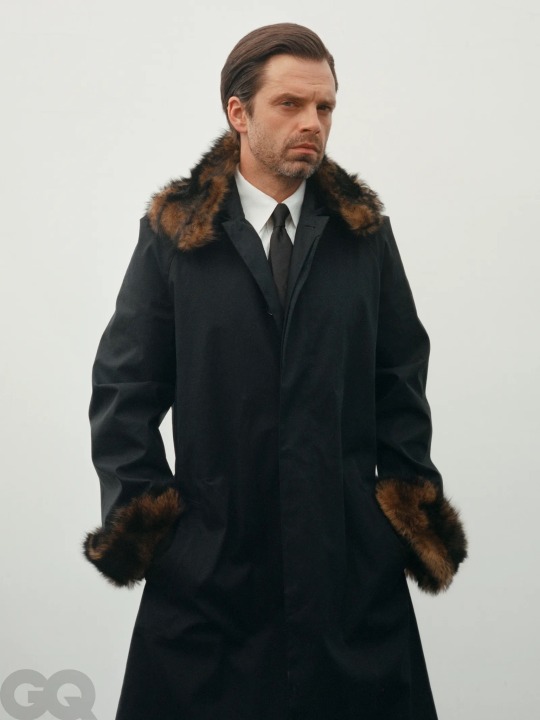
Coat by McQueen. Shirt by Louis Vuitton. Trousers by Louis Vuitton. Tie by Dolce & Gabbana. Boots by Versace. Daniel Jack Lyons
Though the film treads across the noir and comic horror genres, and at points tips into the absurd, it feels most like a parable. “It’s another version of the American dream, right?” Stan says. “Don’t wish for the things you want; you don’t know what’s going to happen.”
During the shoot, Stan often had long stretches between having his facial prosthetics applied and his call time (the film’s make-up designer, Michael Marino, was simultaneously working on The Marvelous Mrs Maisel, and would sometimes have to squeeze Stan into make-up in the early hours before running to that job). So Stan would walk around New York, including parts of his own neighbourhood, wearing hyperrealistic prosthetics, getting just a little taste of what his life would be like if he had been dealt a different hand. At one point, he went to his local coffee shop, where a barista he has known for years was working the counter. “She was so busy handling stuff, and suddenly she turned and she didn’t expect to see me,” he says, “and I could see the shock going immediately into overcompensation.” Pearson told him that those are the reactions that he is most often confronted with as a person with a disability: shock verging on repulsion, and guilty, over-the-top kindness.
Schimberg helped Stan to draw a neat line between Edward’s life and his own experience of fame. The one thing they had in common is how they’re observed in public spaces. “He said, ‘You have to think about what it’s like to be recognised. And the sense that you’re fair game out there.’ That I could understand,” Stan says. “I’ll go to lunch with my mom and somebody will be filming me the entire time, pretending they’re not. Or I’ll see somebody look at me strangely and then they’ll whisper to their friends. Or I’ve had someone come and tap me and run away. The invasiveness of that… And I can’t do anything but just receive it.”
Stan is quick to clarify that his experience as a famous person is not really comparable, that it comes with all sorts of upsides. But this point of similarity helped him to fully embody the character. “That was a way of me understanding this thing – that you’re just out there, like target practice.”

Coat and pyjamas by Dolce & Gabbana. Daniel Jack Lyons
Production on The Apprentice was hazardously stop-start. Several times over, Stan began his Trump immersion routine – which also involved pounding Coca-Colas and peanut butter and jam sandwiches, among other things, to put on some very un-superhero bulk – only to find out that production had been suspended. At one point, the project came so close to overlapping with his next Marvel outing, next May’s Thunderbolts, that he had to start shredding instead – only for Thunderbolts to be postponed because of the WGA and SAG-AFTRA strikes. Straight back to the PB&Js. All that work wasted. “I’m fuckin’ 41; I just worked pretty hard to get in shape here!” he says.
Stan’s Trump is admirably nuanced, particularly for a person who has been so widely imitated – on SNL, on late-night talk shows, every second of every day by comedians trying to make a name for themselves on TikTok – as to be reduced to a caricature in the public consciousness. Initially, it feels quite removed, but then you spot the shape his mouth curves into while enunciating words like “deal” and “loser”, a subtle pursing of the lips when he’s being spoken to, a hand gesture. As the movie progresses, the man with whom we’re all exhaustingly familiar comes closer and closer to the fore.
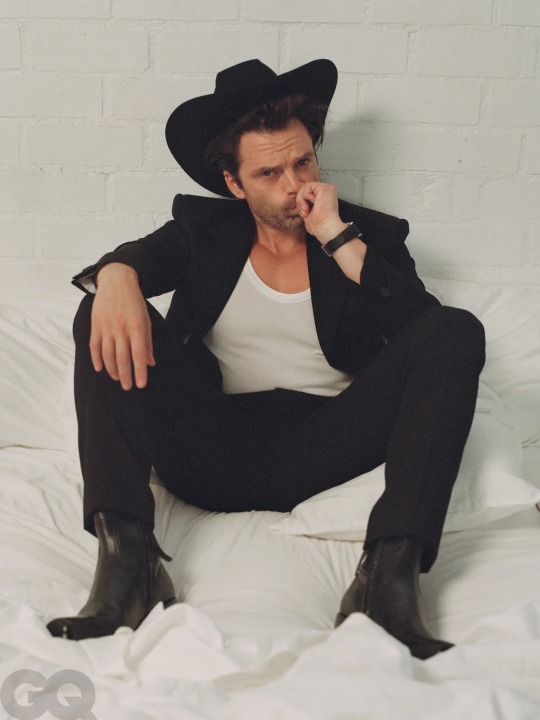
Suit and boots by Versace. Vest top by Schiesser. Hat by Gladys Tamez. Watch by Cartier. Daniel Jack Lyons
The challenge, in Stan’s eyes, was to tread the very fine line between interpretation and imitation. “It’s a balance between having the familiarity without it becoming sort of a schtick,” he says. “There is a small window of time where you are going through the impersonation phase, because you’ve got to get through that in order to come out the other end,” he says. “There is a mechanical, technical piece to it, and that comes from actually studying a person.” According to Stan’s mother, he spent much of his childhood relentlessly impersonating people he came in to contact with. “I’ve always been good at watching people,” he says.
I'm going to commit the fuck out of it and surrender myself to the story.
Once he got comfortable enough, he would take the show on the road – trying versions of the character out in restaurants to see if anyone would pick up on it. “Because there’s a thing getting born,” he says, “and you want to test it out in the world, but you don’t want to overdo it too quickly – then it gets frozen.” No one seemed to notice in the moment, which was at least some indication that he hadn’t tipped over into parody, but some friends who have seen the movie realised retrospectively: “They’ve come up to me after and said, ‘Now I see this fuckin’ weird thing you were doing!’”
When we meet Trump in The Apprentice, he is a footsoldier in his father’s company and significantly less self-assured, though he’s got the trademark wispy hair and the ill-fitting suits. The wheels begin to turn when he meets Cohn – portrayed here in typically committed fashion by Succession’s Jeremy Strong, with whom Stan only had the chance to interact in character on set – who begins to sculpt Trump in his own image, laying out his rules for success, which will be very familiar to anyone who has paid attention to Trump’s political career: 1) attack, attack, attack; 2) admit nothing and deny everything; and 3) always claim victory and never admit defeat.
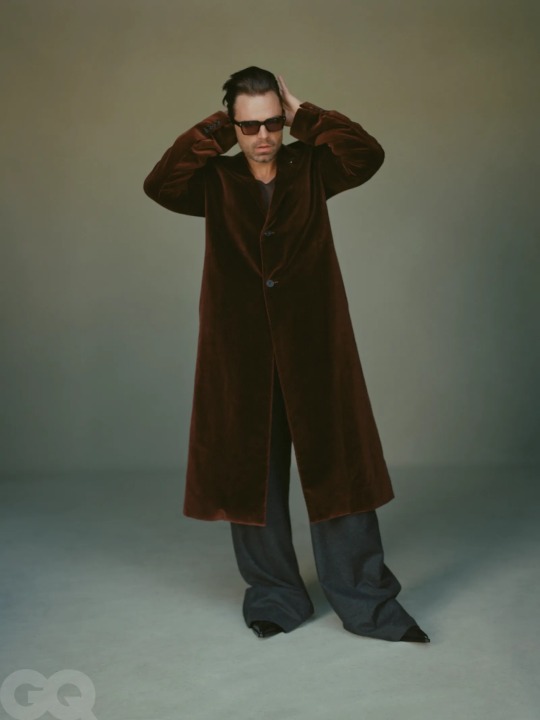
Coat, trousers and shoes by McQueen. Vest top by Ami. Sunglasses by Jacques Marie Mages. Pin by Cartier. Daniel Jack Lyons
Stan seems reticent to get into the politics of The Apprentice, which depicts Trump as, among other things, a rapist, in a scene referencing allegations made in a deposition by his first wife Ivana during their divorce proceedings. (Trump has previously denied the rape allegation; Ivana later issued a statement clarifying that she had felt violated, but was not raped in a “literal or criminal sense”.) But the movie speaks for itself. And Trump’s camp is already speaking back: after the film premiered at Cannes in May, the presidential campaign’s chief spokesperson Steven Cheung called the movie “garbage”, “pure fiction” and “election interference by Hollywood elites”, while also threatening a lawsuit. In a press conference at the film festival, Abbasi suggested that an ideal release date would be in mid-September, to align with the second presidential debate (but the film, as it happens, is now due out on 11 October in the USA, and 18 October in the UK). It wouldn’t take Alan Turing to decipher the message being transmitted. But I try and press for a direct answer: does Stan feel an added sense of responsibility playing Trump in an election year? “You can’t not think about it,” he says. “But I had tremendous trust in Ali Abbasi and his vision for the movie. And it is an important story – I think the movie makes a great attempt at exploring: how did we get here? But I approached it with the same responsibility as I approached anything I ever got involved with, which is, I’m going to give this my all. I’m going to research the fuck out of it; I’m going to commit the fuck out of it and surrender myself to the story.”
Does he have any concerns about backlash from Trump or from MAGA supporters? “I mean, is there anything out there now that doesn’t get backlash? You can’t worry about what people think,” Stan says. “But I’m fully aware that I’m doing things that are not going to be for everybody.”
He’s not far off the mark. Even Marvel, the world’s highest-grossing movie franchise of all time, has faced quite a bit of criticism in recent years – in part for the way in which they’ve handled the transition to a new set of heroes and storylines since 2019’s Avengers: Endgame. Stan doesn’t have any time for it. “I’ve never been part of a company that puts so much heart and thought into anything,” he says. “I think if Marvel was gone, it’d be such a big hole to try and fill up. Don’t just go out there and shit on something without offering something better.”
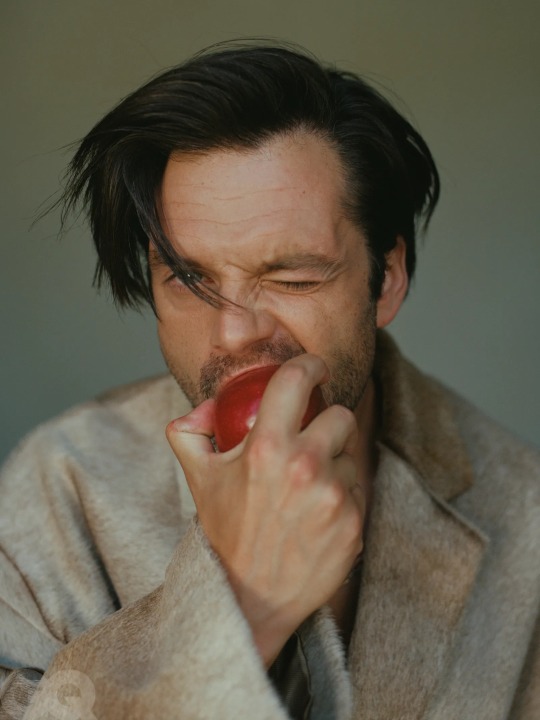
Coat by Loewe. Boots by Dolce & Gabbana. Necklace by Cartier. Daniel Jack Lyons
He’s certainly not done with the MCU yet. Thunderbolts, which he’ll headline alongside Florence Pugh, will arrive in May next year. And he’s already looking beyond that, to a potential reunion with Robert Downey Jr, who has been announced to return in the next Avengers movie – not as Iron Man, but as the villain Doctor Doom. “I hope I’m in a scene with him,” Stan says. “Is there any other guy that could pull that off? I don’t know, probably not. After Tropic Thunder, is there anything that guy can’t do?” he says, laughing. It is perhaps the movie that I least expect Stan – or anyone, to be honest – to reference in 2024, but I should know better. Downey Jr is a transformation master, too. Game recognises game.
Trump doesn’t exist in the Marvel universe – or at least not yet – but if you spot a hint of him in Thunderbolts, you’ll know why. “I went off to Marvel after [The Apprentice],” Stan says. “And we were doing scenes, and I would do something, a thing or two, and be like, ‘Fuck! This is still living somewhere.’”
Styled by Sean Knight Hair by Erica Adams Grooming by Kc Fee using iS Clinical at Redefine Representation Set Design by Daniel Horowitz Production by May Kielany
#Sebastian Stan#The Apprentice#A Different Man#Thunderbolts*#Interview#Photoshoot#GQ British#GQ Hype#GQ#mrs-stans
70 notes
·
View notes
Text
Newsies Halloween 2024 | 9th June
Hey all! Final post for this article of the paper!! And as per usual, if you have any feedback, constructive criticism or notice any errors, feel free to let me know!
~~~~~~~~~~
Who Were The Newsies?
Up until the 1900's, young boys and girls would hawk at street corners, waving the daily newspaper high above their heads, desperately trying to sell them for a penny per paper, these were known as newsies. Throughout history, these poor children (often no older than thirteen) were frequently mistreated by the upper-class members of society, including their own employers. The papers were often overpriced and the newsies were forced to lie their way into selling papers if there wasn't a truthful headline they could shout into the streets.
The newsies would often go on strike in an attempt to receive better pay or treatment. But, the owners of the various papers paid them no heed as they assumed that within a few days the newsies would realise that their lack of work equated to less money to afford shelter and food. But there was one strike that didn't proceed as anticipated and changed the course of history forever.
The Newsboys Strike of 1899
While this strike began in 1899, it's story begans a bit earlier. In 1898, during the Spanish-American war, paper sales skyrocketed. Newspaper owners were keen to cash in on this sudden craze for papers, they decided that the best way to do so was to raise the price of newspapers bought by the newsies themselves. At the time, the newsies weren't too highly distraught, as the were selling well enough to buy the newly priced newspapers, which were raised from 50 cents per hundred to 60 cents.
After the war officially ended in August of that year, many newspapers lowered their prices. But, two notable newspapermen hadn't budged their price. These men were William Randolf Hearst of The Journal and Joseph Pulitzer of The World.
Once almost a full year had passed the circulation was down and the 10-cent extra was yet to be removed, the young newsies had found themselves down in the dirt and having to eat their unsold papers. By the summer of 1899 they decided that enough was enough, and on July 19th the Lower Manhattan newsies had gathered in City Hall Park and formed a union. Soon word spread about this union and they declared that if prices were not dropped they would strike.
In the early days of the strike, the newsies were violent. If anyone was discovered to be selling the newspapers, they would be swarmed and beaten with their papers being completely destroyed. The owners were desperate to keep their sales up, so they paid adult men to sell their papers with the promise of police protection, but the striking children would often find ways to pass the police and get their hands on these "scabbing" men. There was one famous incident of the newsies surrounding and tipping over a newspaper wagon to stop it from delivering papers throughout the city.
Despite the challenges they faced, the newsies persevered. To get word out to as many people as possible to boycott the newspapers, they created flyers and banners which were scattered throughout the city and handed to people in the streets.
July 26th 1899, Kid Blink and David Simmons, the leaders of the strike, were rumoured to have betrayed the union and agreed to sell the newspapers in exchange for money and bribe. While they repeatedly denied these accusations, the newsies pointed out their new-looking suits which they believed to be proof of the boys working for the newspaper excecutives for higher pay. Due to the mounting suspicions, Blink and Simmons both stepped away from their leadership roles to try avoid any more speculation.
After Kid Blink and David Simmons left their positions, the union found itself without leaders. Other newsies stepped up to try keep the union together but none of them held the same power that the two boys once did.
On the 1st of August, the newspaper owners finally gave in and offered the newsies a compromise. The newspaper price would stay at 60c but any unsold papers would be bought back from the newsies - this ensured that the newsies wouldn't need to sell for hours after dark to avoid losing possible pay. The newsies accepted this deal and the strike was officially ended on the 2nd of the same month.
During the strike, there were many people outside of the newsies that risked their social status and safety to offer them aid in their dire time of need. One of the most discredited was Annie Kelly. She was a newswoman and was very popular among the newsies for being one of the few newswomen who were loyal to the strike. She was also known as the newsies ‘patron saint’. During a rally held by the newsies at The Irving Hall, she was the only woman to make a speech.
***
Since the strike, the newsies have been immortalised in many pieces of media. The 1992 Disney film was inspired by these courageous newsboys and girls. And while many parts have been altered, it still shares a powerful message, commemorating the efforts of these children whose actions started a children's rights movement which spread far across America. The impacts of this movement are still seen today and ensured a safer future for hundreds of children.
~~~~~~~~~~
If you have any questions, feel free to contact either @scottzerrss or myself :)
(Also this post will be continued to be edited rather than me having to rewrite it every time I want to post it :))
17 notes
·
View notes
Note
RACETRACK MOTHERFCKING HIGGINS YOU GOSH DARN HISTORY NERD
RACERACERACERACERACERACE
also, i feel so seen rn *wipes away emotional tear*
so, ed ‘racetrack’ higgins was a newsie who helped lead the 1899/1900 newsboys’ strike against william randolph hearst and joseph pulitzer with louis ballat (who was known as kid blink), dave simons (who we don’t know the newsie name of), and (reportedly, because there aren’t that many sources with him) spot conlon (and, honestly? they could have been the same kid. not likely, but possibly). he was a brooklyn newsboy (from brighton beach specifically), and was between the ages of 16-21. he spent a considerable amount of time between the two racetracks he was near (hence the nickname). he had talked about william c. whitney, who owned a private racetrack, trained horses, and spent a lot of time at sheepshead (he said he had run horses for him, but that could be false). in just about every article he was interviewed for, it was noted that he talked A LOT about the races, even when they weren’t mentioned. like, at all (I love that for him, actually). he was charismatic, bold, and a natural-born leader. unfortunately, after the strike, he essentially disappears. there were a lot of ed higgins in the new york/jersey area, and it’s hard to track an idividual person, especially after the war started.
for more historical racetrack stuff, go check out @musicalcuriosity ‘s blog, they’ve got some great stuff over there.
now, because this isn’t actually my historical area of expertise, AND because I have actual hcs, we’re going to move on to the fun stuff.
ANTONIO ‘racetrack’ higgins is a manhattan newsie. he’s the second in command to jack kelly and more or less the ambassador to brooklyn. he’s snarky, loves gambling and spot conlon, and is probably the reason adderall was invented. he’s brilliant with numbers, but couldn’t tell you how to spell algebra to save his life. he’s petty, smokes more than anyone should, and will risk life and limb for those that he loves. he doesn’t plan to make it to 25, but will lie to anyone who asks and says he wants to be doctor for kids.
he becomes a newsie at nine, right after his mom dies, and he looks (maybe) seven, so he’s immediately taken under the wing of an older newsie. he’s dragged to the races after they finish selling, and it’s like something just clicks inside of him. he notices the trends, gets good at counting the cards, finding the tells of a good bet.
when asked, he would just shrug, a jaunty grin on his face. “it’s jus’ numbers,” he would say.
he meets a young francis sullivan (newly jack kelly) and charlie (now crutchie) when he stumbles upon their hiding spot in an alley. he recognized jack, and laughed instead of cowering when he threatened to soak him. he cheerfully informs them of a better place to hide on top of the lodging house, and from then on, they’re brothers friends.
he travels to brooklyn by himself the first time on a dare from albert (who has since become his best friend), and gets caught by hotshot within thirty minutes. he gets told to never come back with a hearty punch to the ribs for good measure.
he returns the next day.
he’s not allowed coffee (per jack), because he’s apparently “too damn jittery” as it is.
he can speak a little bit of italian, and converses with itey when they’re both at the lodging house. if he’s in public, he pretends he doesn’t know any.
when finch and albert start dating, part of him is sad, no matter how happy the rest of him is. it’s not fair, and he doesn’t know why, but it feels like a door’s shutting. he laughs, and holds spot a little tighter afterwards.
skittery taught him how to throw his first real punch, and then immediately started a fight with him “to make sure he understood the lesson”.
he’s scared of loud thunderstorms.
he hates the sound of a creaky wheel on a carriage.
he doesn’t mind girls, but he would prefer short brunettes with a temper (he’s very much got a type, and he’s not ashamed of it).
he would love harry potter, but despise JKR.
he believes in god, but doesn’t go to church.
if he had a kid, he would name them either maria or sebastian, after his mother and uncle respectively.
#i love this man#newsies#92sies#uksies#livesies#racetrack higgins#sprace#race x spot#antonio higgins#racetrack newsies#spot conlon#jack kelly#crutchie morris#crutchie newsies#francis sullivan#emme’s bad ideas
85 notes
·
View notes
Text

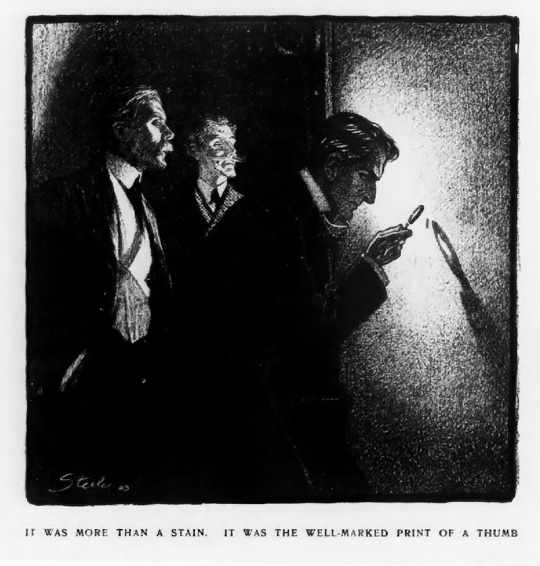
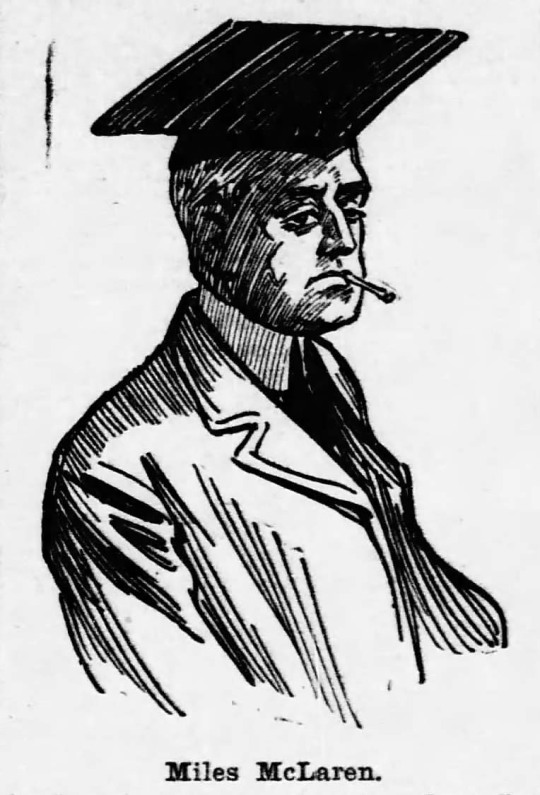
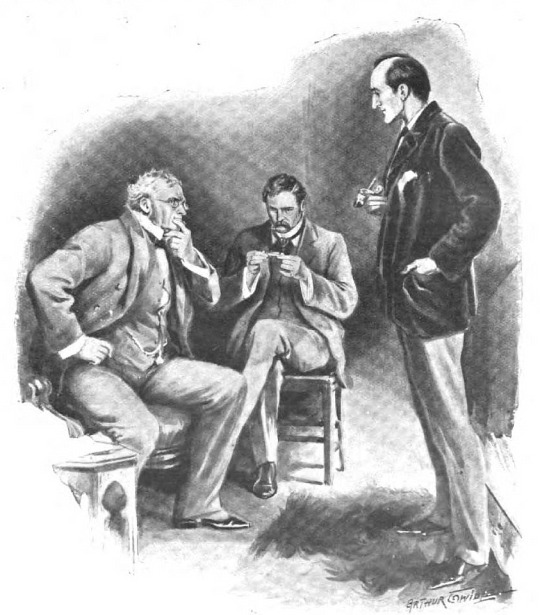
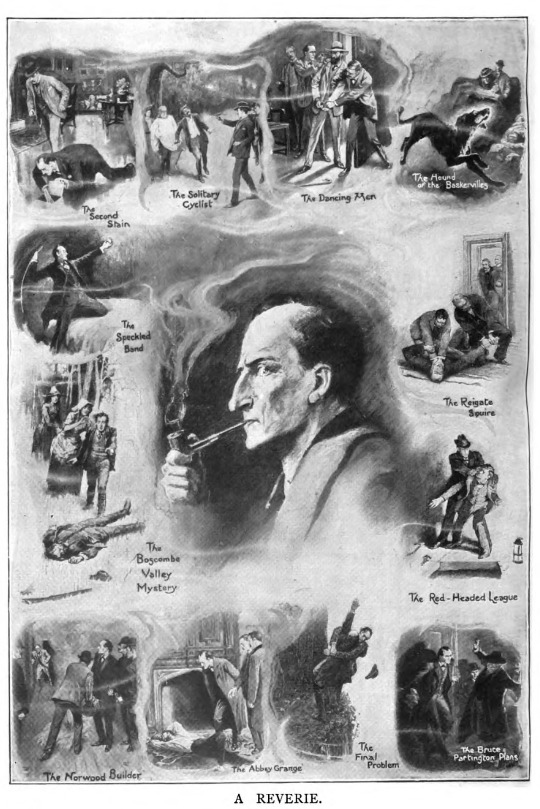

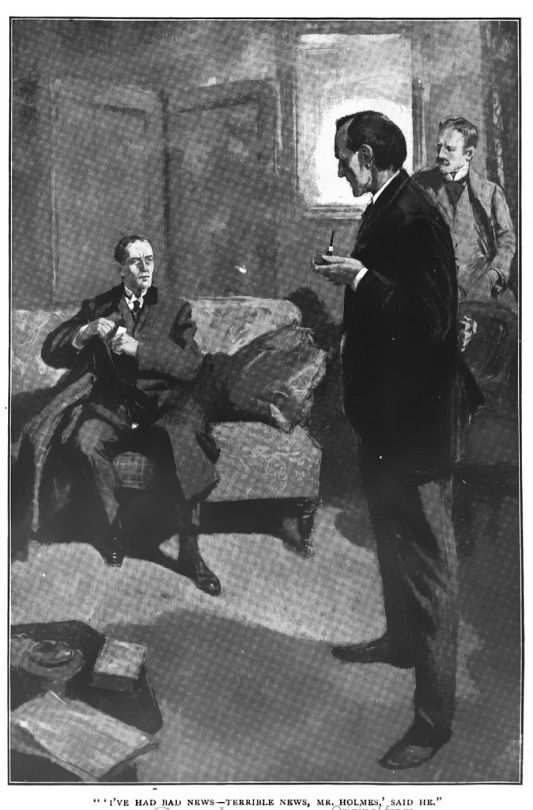


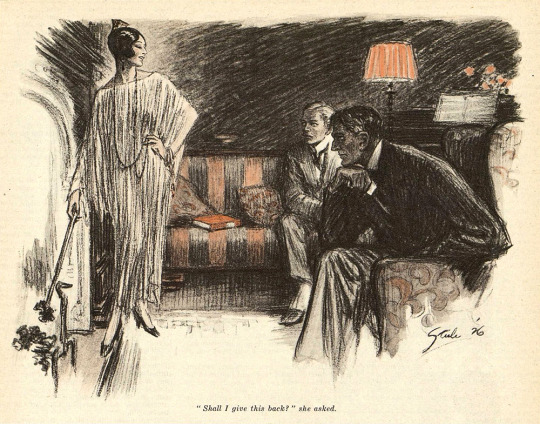
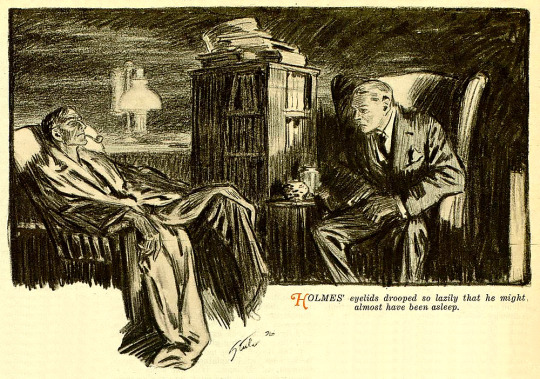
Vote for your favourite, the top 9 will proceed in the bracket. Since theyre all different shapes and sizes, make sure to click into the full views!
Paget Eliminations / Other Artist Eliminations
Full captions and details for each illustration below the cut:
"I was shocked to see he was staring at me with a perfectly blank face." W.H. Hyde, Resident Patient (Harper’s Weekly) Characters: Percy Trevelyan, 'Russian Nobleman'
"It was more than a stain. It was the well-marked print of a thumb." FD Steele, Norwood Builder (Collier’s) Characters: Watson, Lestrade, Holmes
"Miles McLaren." FD Steele, Three Students (Collier’s) Characters: Miles McLaren
"But I have been running around and making inquires before I came to you." Arthur Twidle, Wisteria Lodge (The Strand) Characters: John Scott Eccles, Watson, Holmes
"A reverie" Joseph Simpson, Red Circle (The Strand) Characters: Holmes &c.
"Leaning forward in the cab, Holmes listened intently to McDonald's short sketch of the problem which awaited us in Sussex." Frank Wiles, Valley of Fear (The Strand) Characters: Watson, Holmes, MacDonald
"I've had bad news - Terrible news, Mr. Holmes." Frank Wiles, Valley of Fear (The Strand) Characters: MacDonald, Holmes, Watson
"She poured her whole wild fury out in burning and horrible worlds - I put my hands to my ears and rushed away." Alfred Gilbert, Thor Bridge (The Strand) Characters: Maria Gibson, Grace Dunbar
"Mrs. Ferguson kneeling by the cot gave no answer to her husband's reproaches save to gaze at him with a wild despairing look in her eyes." WT Benda, Sussex Vampire (Hearst’s International) Characters: Baby Ferguson, Mrs Ferguson
"Shall I give this back?" she asked." FD Steele, Three Gables (Liberty) Characters: Isadora Klein, Watson, Holmes
"Holmes' eyelids drooped so lazily that he might almost have been asleep." FD Steele, Retired Colourman (Liberty) Characters: Holmes, Watson
#acd holmes#sherlock holmes#tumblr bracket#sherlock holmes illustrations#elim poll#oa elim#polls full bracket
20 notes
·
View notes